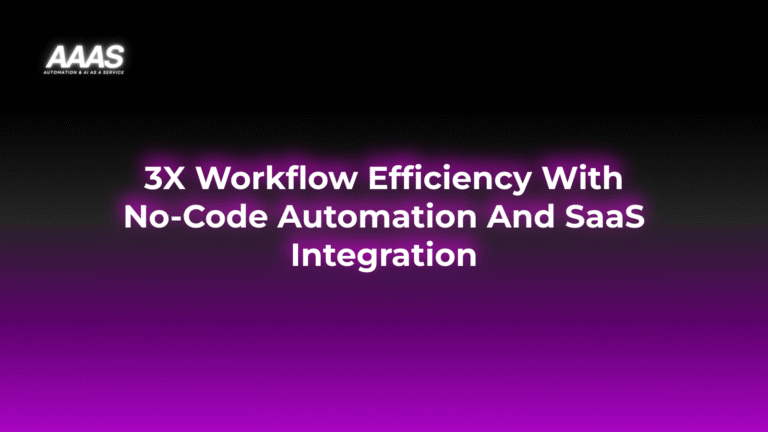Leveraging No-Code Automation and SaaS Integration for Streamlined Business Workflows
Market Problem
Businesses today are inundated with repetitive, manual processes across disconnected SaaS platforms. These fragmented workflows drain time, inflate operational costs, and reduce overall productivity. Rapid software adoption without integration leads to data silos, poor collaboration, and costly human errors. The technical barriers of traditional automation and the reliance on IT teams also slow down digital transformation, putting organizations at a competitive disadvantage.

Solution & Benefits: No-Code Automation & SaaS Integration
No-code automation platforms empower businesses to automate workflows and integrate SaaS applications without writing code. With pre-built connectors, intuitive drag-and-drop interfaces, and customizable triggers, anyone—from operations staff to marketers—can build robust automated workflows.
Key Benefits
- Enhanced Efficiency: Automate repetitive tasks, synchronize data instantly, and eliminate manual intervention.
- Cost Reduction: Minimize IT dependency, reduce software development and maintenance costs, and free up human resources.
- Boosted Productivity: Enable teams to focus on high-value work by reducing administrative tasks.
- Data Accuracy: Cut down on human error by automating data entry and transfer.
- Scalability: Easily add new services and adapt workflows as your organization grows.
Real Use Cases
- Lead Management Automation: Automatically capture leads from web forms into CRMs like Salesforce or HubSpot and assign follow-up tasks in project management tools such as Asana or Trello.
- Invoice Processing: Sync data between accounting solutions (QuickBooks, Xero) and payment gateways, triggering automated emails upon invoice payment.
- Employee Onboarding: Integrate HR software with IT tools to automate account creation, send onboarding emails, and schedule training sessions.
- E-commerce Order Fulfillment: Connect Shopify with inventory management and logistics tools to process orders without manual intervention.

Technical Details
How No-Code Platforms Work
- Integrators & Connectors: Pre-built modules for popular apps (e.g., Slack, Google Workspace, Salesforce).
- Triggers & Actions: Define what event starts a workflow (trigger) and the resulting operations (actions).
- Conditional Logic: Set branching rules based on data values or outcomes.
- Data Transformation: Map and modify data fields between SaaS apps to ensure compatibility.
- Scheduling & Monitoring: Run automations on set intervals and monitor for errors or exceptions.

Comparison with Alternatives
| Solution | No-Code Automation | Custom Code Integration | Manual Processes |
|---|---|---|---|
| Implementation Time | Minutes to Hours | Weeks to Months | Immediate |
| Technical Skill Needed | Low (No IT required) | High (Developers/IT) | None |
| Flexibility | High | Very High | Low |
| Scalability | Excellent | Good | Poor |
| Maintenance Cost | Low | High | High (Labor) |
| Error Rates | Low | Low | High |
Pricing Table (Popular No-Code Platforms)
| Platform | Free Tier | Paid Plans (USD/month) | Main Features |
|---|---|---|---|
| Zapier | Yes | 19.99 – 799 | Hundreds of app integrations, multi-step workflows, filters |
| Make (formerly Integromat) | Yes | 9 – 29 | Visual automation builder, advanced logic, extensive modules |
| Workato | No | Contact Sales | Enterprise focus, deep integrations, AI automation |
| Tray.io | No | Contact Sales | API automation, advanced data mapping, enterprise connectors |
ROI-Focused Practical Examples
- Marketing Agency: Saved 30+ hours per month by automating social media reporting and client onboarding, leading to $5,000 reduction in labor costs annually.
- E-commerce Retailer: Reduced order processing time by 65%, cutting fulfillment costs and enabling faster shipping, which improved customer satisfaction and repeat sales.
- SaaS Startup: Automated lead qualification and nurture workflows provided a 2x increase in sales team efficiency without additional headcount.
Setup Steps
- Identify repetitive manual processes suitable for automation.
- Choose a no-code automation platform matching your SaaS stack (see Pricing Table).
- List the SaaS tools to be connected (e.g., CRM, email, finance apps).
- Map out workflow steps, triggers, and desired actions on paper or digitally.
- Use drag-and-drop interfaces to build and test the workflow in your no-code tool.
- Deploy the automation, monitor for errors, and iterate as business needs evolve.
Pros and Cons
| Pros | Cons |
|---|---|
|
|
Expert Tips
- Start with small, high-impact automations to prove ROI before scaling platform-wide.
- Train non-technical staff to own and manage their workflows.
- Regularly audit automations for redundancy and performance optimization.
- Choose platforms with responsive support and transparent pricing models.
- Check for integrations with your current and future SaaS stack to avoid switching costs.
- Document all automation workflows for compliance and knowledge sharing.
FAQ
- Can no-code automation handle complex business workflows?
- Yes, modern no-code platforms offer advanced features like conditional logic, loops, and data transformations suitable for most business scenarios. For highly complex needs, hybrid no-code/low-code platforms may be required.
- Is my data secure with SaaS integrations?
- Leading platforms use encryption and comply with security standards such as SOC 2, GDPR, and HIPAA. Always review each provider’s compliance certifications.
- What are the most common SaaS integrations?
- CRM (Salesforce, HubSpot), email (Gmail, Outlook), storage (Google Drive, Dropbox), finance (QuickBooks, Xero), chat (Slack, MS Teams) are among top integrations.
- Can I migrate or export workflows if I switch platforms?
- Many platforms offer import/export features, but custom integrations may need to be rebuilt. Document workflows for easier migration.
- How does no-code automation compare with RPA?
- No-code workflow automation connects cloud apps via APIs, while RPA (Robotic Process Automation) mimics human actions on UI—useful for legacy systems without APIs. Both approaches can be combined for complete automation.
References & Citations
- G2: No-Code Automation Explained
- Gartner Market Forecast, Mar 2024
- Zapier: Introduction to No-Code
- Forrester Wave: Digital Process Automation, 2023
Last updated:








